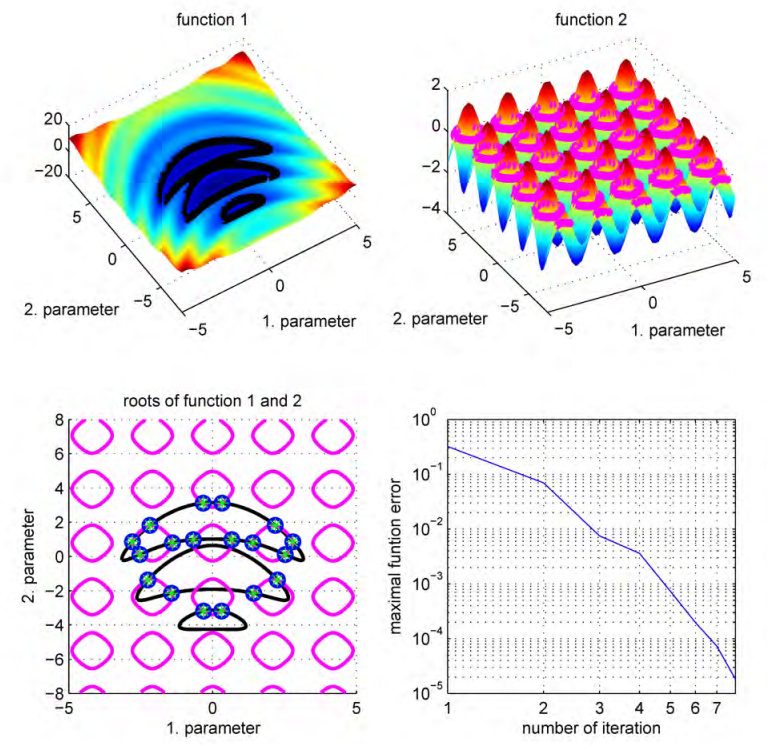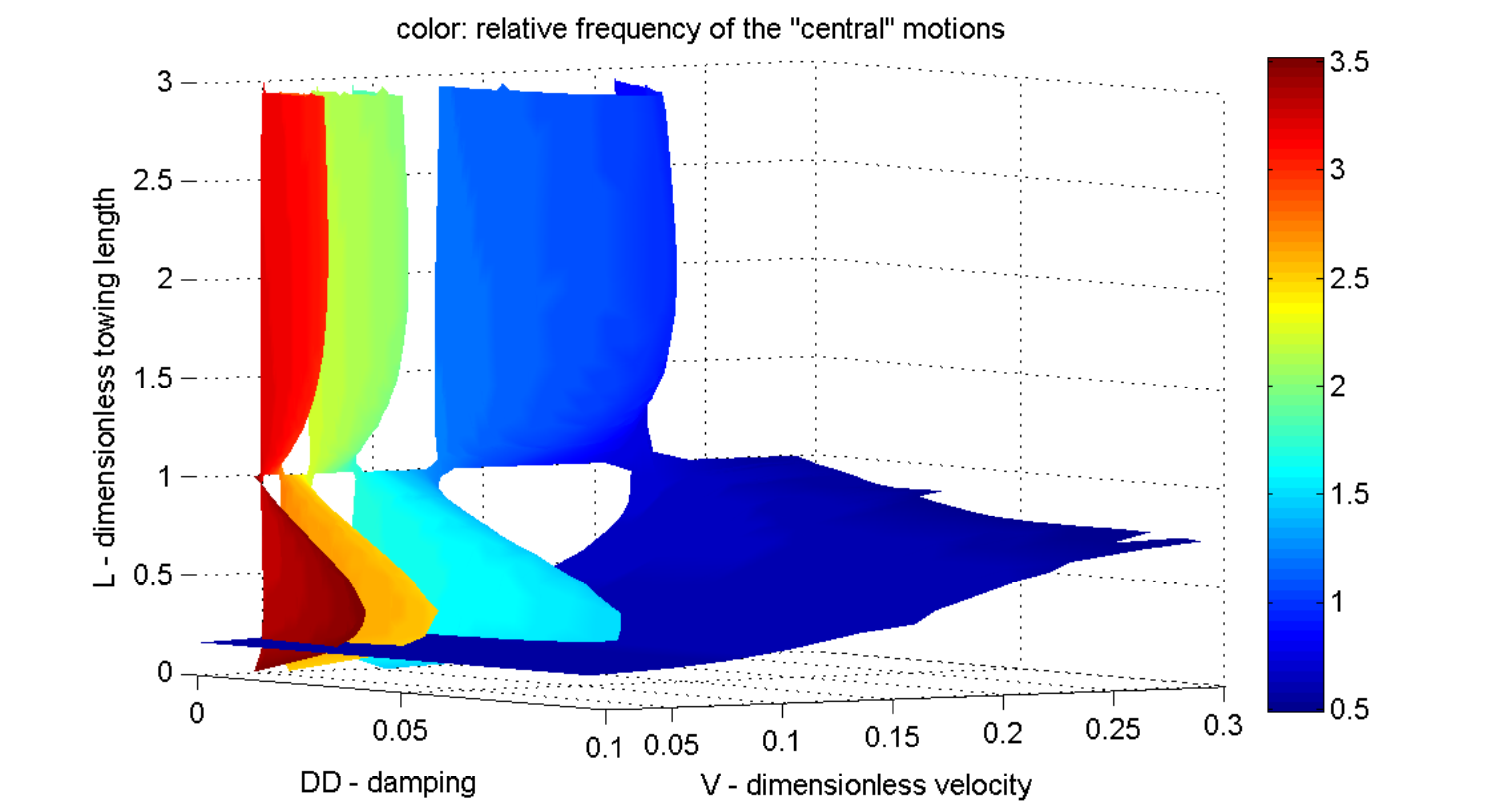
Bachrathy Dániel
adjunktus
BME Műszaki Mechanikai Tanszék
Budapesti Műszaki és Gazdaságtudományi Egyetem
- E-mail: bachrathy@mm.bme.hu
- Telefon: +36-1-463-1368
- Fax: +36-1-463-3471
- Cím: 1111 Budapest, Műegyetem rkp. 5. MM. ép. fszt. 8.
Szoftver Csomag
Multi-Dimensional Bisection Method
Harmonic Balance for Delayed Systems
Kutatás
Kutatási projektek
Ipari projektek
Szcientometria
Multi-Dimensional Bisection Method (MDBM)
 The bisection method - or the so-called interval halving method - is one of the simplest root-finding algorithms which is used to find zeros of continuous non-linear functions. This method is very robust and it always tends to the solution if the signs of the function values are different at the borders of the chosen initial interval.
The bisection method - or the so-called interval halving method - is one of the simplest root-finding algorithms which is used to find zeros of continuous non-linear functions. This method is very robust and it always tends to the solution if the signs of the function values are different at the borders of the chosen initial interval.
Geometrically, root-finding algorithms of f(x)=0 find one intersection point of the graph of the function with the axis of the independent variable. In many applications, this 1-dimensional intersection problem must be extended to higher dimensions, e.g.: intersections of surfaces in a 3D space (volume), which can be described as a system on non-linear equations. In higher dimensions, the existence of multiple solutions becomes very important, since the intersection of two surfaces can create multiple intersection curves.
In the proposed project an efficient root finding algorithm will be implemented, which can determine whole high-dimensional submanifolds (points, curves, surfaces…) of the roots of implicit non-linear equation systems, even in cases, where the number of unknowns surpasses the number of equations. With order-of-magnitudes less function evaluation than the brute-force method
References
▪ Bachrathy Dániel, Stépán Gábor, Bisection method in higher dimensions and the efficiency number.PERIODICA POLYTECHNICA-MECHANICAL ENGINEERING 56:(2) pp. 81-86. (2012)
DOI: 10.3311/pp.me.2012-2.01
Download
| Implementation | link |
|---|---|
| Matlab direct (zip) | Pack: .m & .p files, exampels, user's guide ---Under construction--- Deadline 2018.Dec. |
| Matlab github | github repository ---Under construction--- Deadline 2018.Dec. |
| Julia direct | mdbm.jl ---Under construction--- Deadline 2019.Feb |
| Julia github | github repository ---Under construction--- Deadline 2019.Feb |
Harmonic Balance for Delayed Systems (HBDS)
 Fast stability chart computation in frequency domain fortime periodic systems with multiple time delays
Fast stability chart computation in frequency domain fortime periodic systems with multiple time delays
A complex numerical method were implemented to analyse Delayed Linear Time Variant (D-LTV) systems. Our main goal was to create the so-called stability chart, which shows the stable regions in a given parameter range. The developed numerical method is capable to detect the stable regions fully automatically for optional number of parameter. The method is optimized for 2 parameters, which is the most important for the technical point of view. A 2D stability chart can be constructed under seconds even for very complicated systems. 3 parameter is also supported and tested, but its computational time is significantly higher. Theoretically 4 and higher number of parameters could also be analysed, but it is not tested and memory problems can easily occur.
The program is capable to use GPU array to accelerate the computation (only for Matlab version R2012a (or higher)).
References
▪ Bachrathy Dániel, Gábor Stépán, Efficient stability chart computation for general delayed linear time variant systems.Proceedings of the ASME 2013 International Design Engineering Technical Conferences & Computers and Information in Engineering Conference IDETC/CIE 2013, August 4-7, 2013, Portland, Oregon, USA
▪ Bachrathy Dániel, Gábor Stépán, Online chatter prediction based on imperfect FRF measurements
CIRP Annals Manufacturing Technology, 63rd CIRP General Assembly, August 18-24, Copenhagen, Denmark
Download
| Implementation | link |
|---|---|
| Matlab | HBDS - Matlab Pack ---Under construction--- Deadline 2019.May. |
| Matlab | github repository---Under construction--- Deadline 2019.May. |
Kutatási projektek
| 2017 – 2021 | Vezető kutató | Összetett Forgácsolási Modellek Nagyteljesítményű Számítástechnikája Országos Tudományos Kutatási Alapprogramok (NKFI-FK 124462) |
| 2017 – 2020 | Vezető kutató | Összetett Késleltetett Dinamikai Modellek Nagyteljesítményű Számítástechnikája Országos Tudományos Kutatási Alapprogramok (NKFI-PD 124646) |
| 2015 – 2019 | Munkacsomag Vezető | SIREN - Stability Islands: Performance Revolution in Machining ERC Advanced Grant (Agreement N°340889)s PI: Stepan Gabor |
| 2014 – 2017 | Vezető kutató | Dinamikai rendszerek robusztus stabilitása Országos Tudományos Kutatási Alapprogramok (OTKA-PD 11298) |
| 2010 – 2013 | Kutató | DYNXPERT - Development a series of portable plug-and-produce components to improve the overall productivity and process quality of production line EU 7-es projekt: EU FP7 NMP2-SL-2010-260073 |
| 2007 – 2008 | Kutató | ACROBOTER - 'Autonomous Collaborative Robots to Swing and Work in Everyday EnviRonment' EU 6-es projekt: - EU FP6 IST-2006-045530 |
Ipari projektek
| 2018 | Úthiba detektálása rezgésjel alapján |
| 2017 | Kormányoszlop és kormány rúd modális vizsgálata, Bosch |
| 2015 | Talajdöngölés rezgéstani vizsgálata |
| 2014 | Lengésfolytó rendszer numerikus analízise |
| 2013 | Dinamikai labor oktatás Bosch dolgozóknak |
| 2013 | Tartószerkezet modális analízise |
| 2010 | Hengerállvány rezgések vizsgálata, Aloca Kft. |
| 2009 | Nyomás független konstans térfogatáramú pillangószelep fejlesztése |
| 2008 | Nemlineáris áttételű tükörmozgató mechanizmus tervezése |
| 2008 | Forgó tárcsa dinamikus kiegyensúlyozása mérési jel alapján |
Szcientrometria
| Adatbázis | Link | |
|---|---|---|
| Google Scholar | ||
| Magyar Tudományos Művek Tára | ||
| Scopus | ||
| ResearcherID | ||
| ResearchGate |